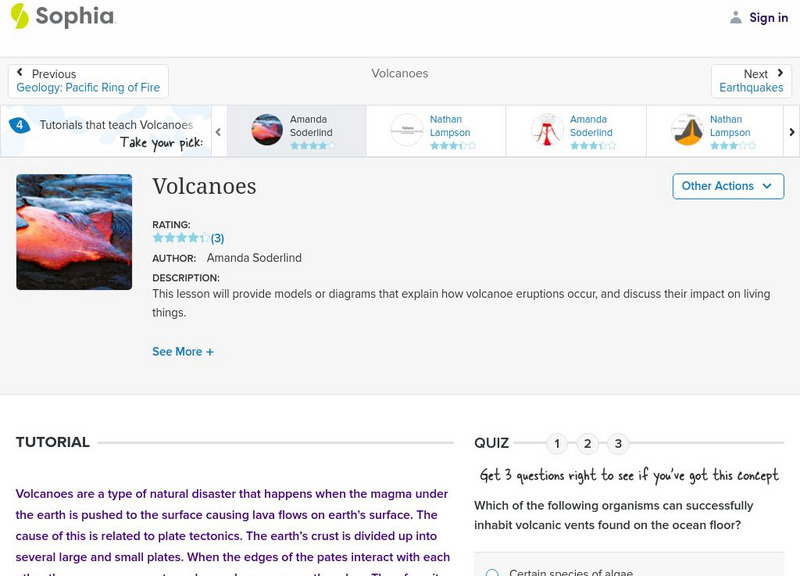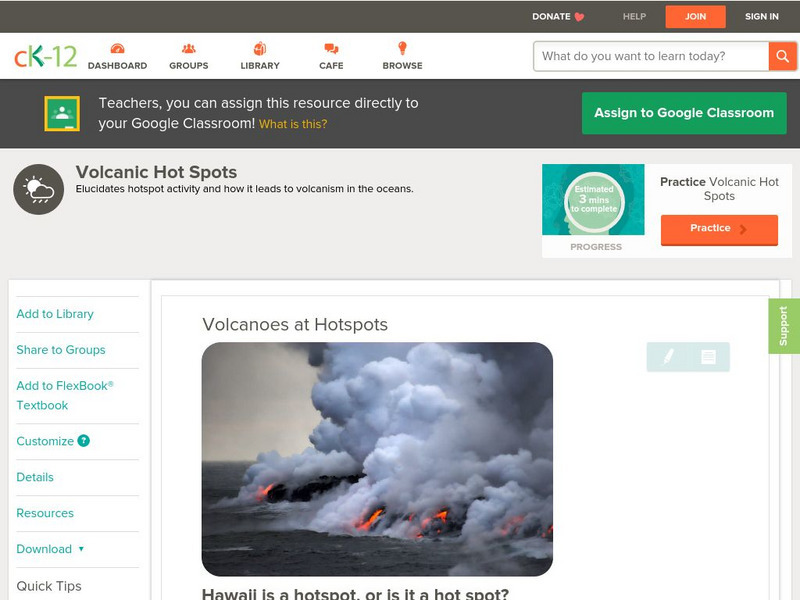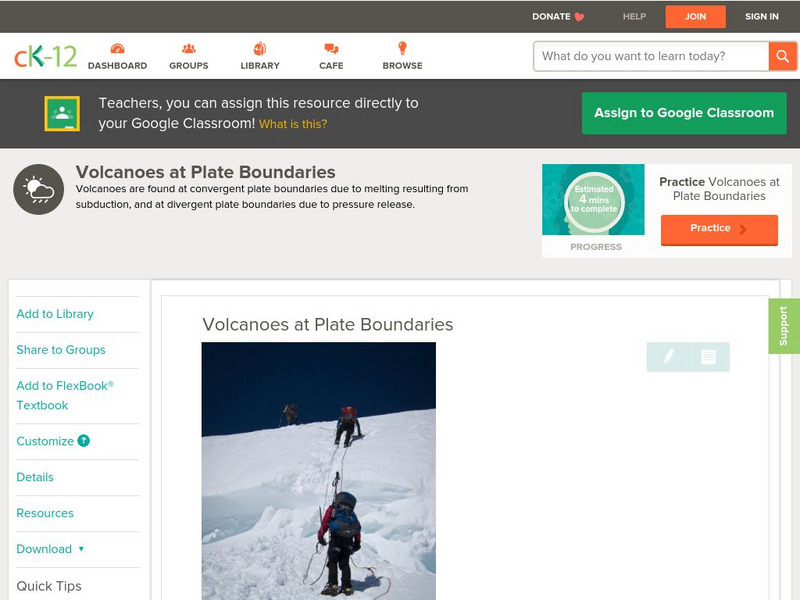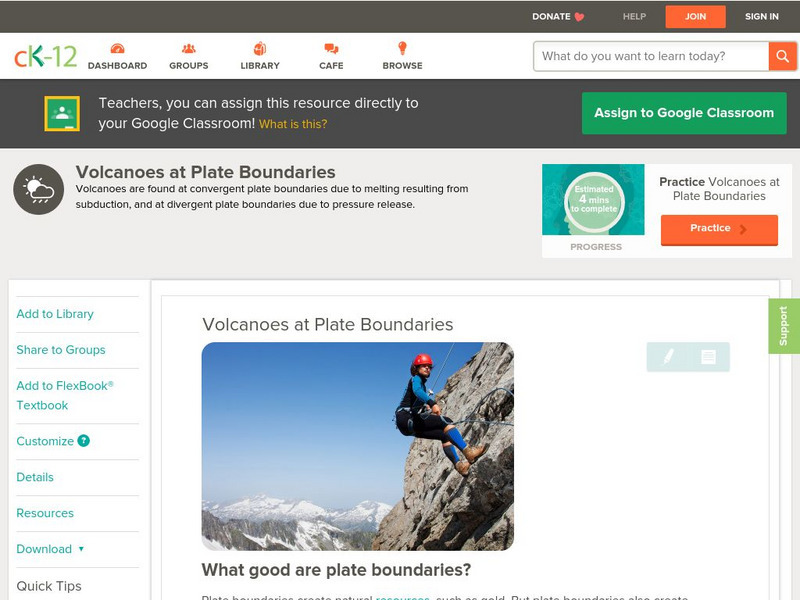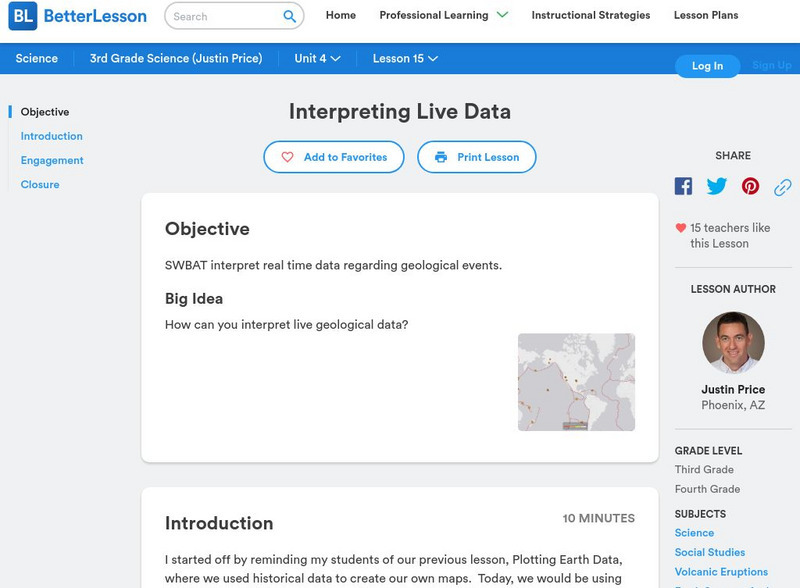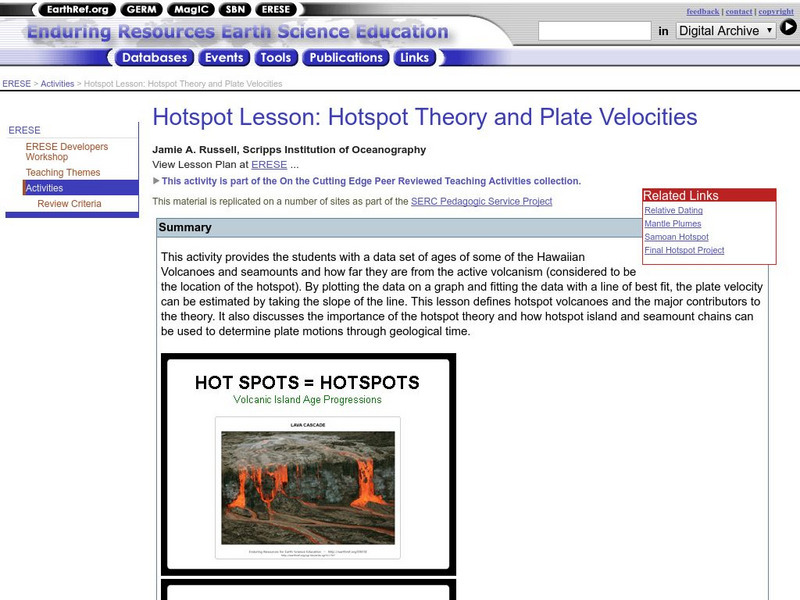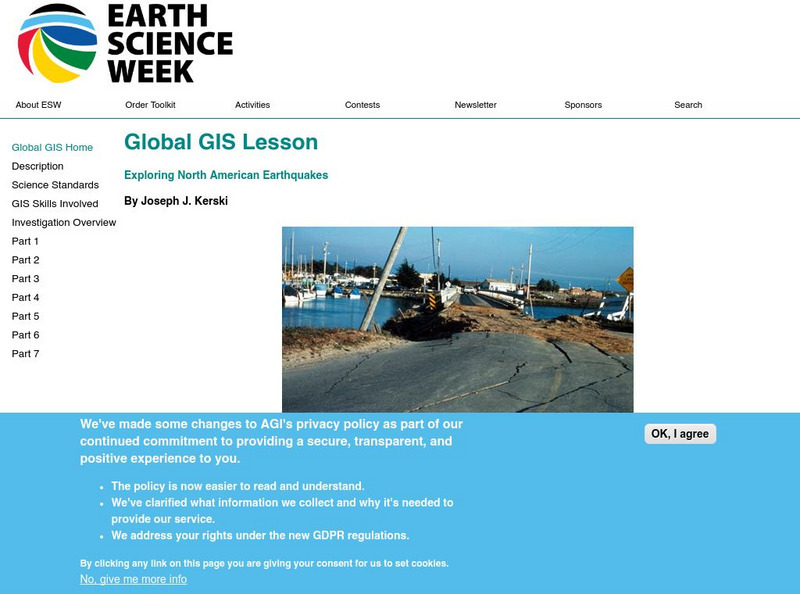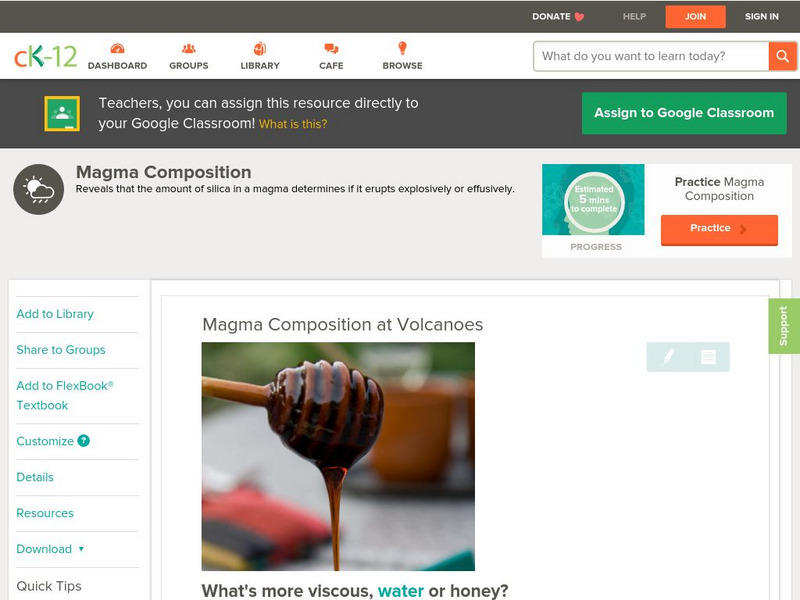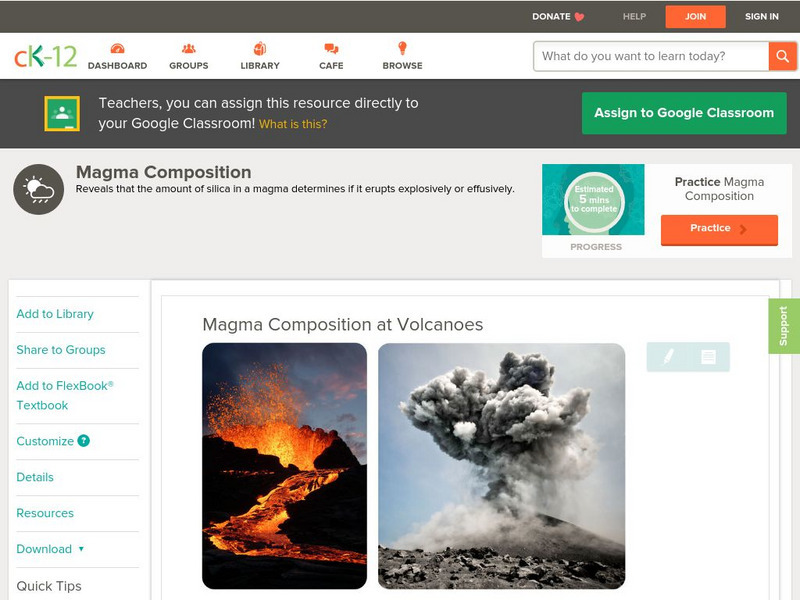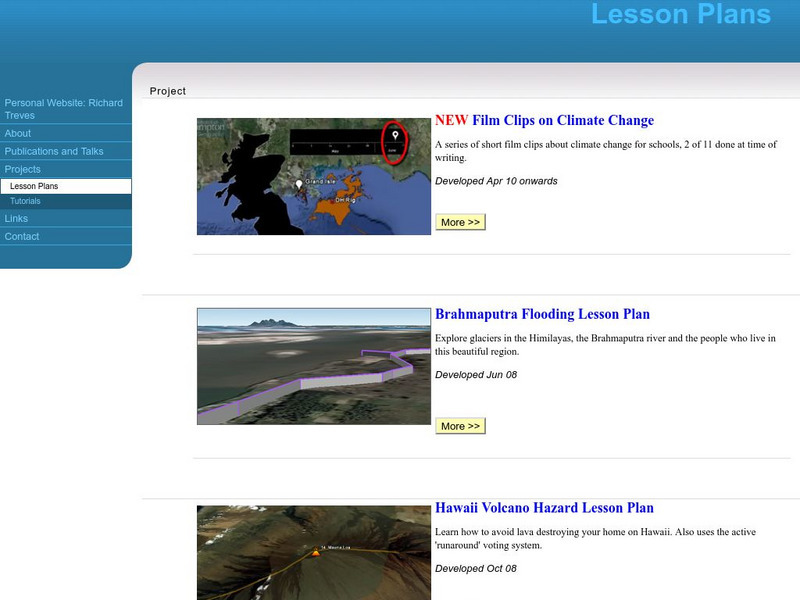Sophia Learning
Sophia: Volcanoes: Lesson 5
This lesson will provide models or diagrams that explain how volcanic eruptions occur, and discuss their impact on living things. It is 5 of 5 in the series titled "Volcanoes."
Sophia Learning
Sophia: Volcanoes: Lesson 4
This lesson will provide models or diagrams that explain how volcanic eruptions occur, and discuss their impact on living things. It is 4 of 5 in the series titled "Volcanoes."
Crayola
Crayola: Birth of Islands (Lesson Plan)
This site is a lesson plan that incorporates language arts, social studies, science, and art. After studying islands, and how they're formed, students create their own models using clay. Also provides resources and adaptations. (To...
CK-12 Foundation
Ck 12: Earth Science: Volcano Characteristics
[Free Registration/Login may be required to access all resource tools.] What volcanoes are and where they are located.
CK-12 Foundation
Ck 12: Earth Science: Volcano Characteristics
[Free Registration/Login may be required to access all resource tools.] What volcanoes are and where they are located.
CK-12 Foundation
Ck 12: Earth Science: Volcanoes at Hotspots
[Free Registration/Login may be required to access all resource tools.] Volcanoes can form at hotspots away from plate boundaries. This article discusses hotspot activity and how it leads to volcanism in the oceans.
CK-12 Foundation
Ck 12: Earth Science: Volcanoes at Plate Boundaries
[Free Registration/Login may be required to access all resource tools.] Volcanoes most often occur at plate boundaries.
CK-12 Foundation
Ck 12: Earth Science: Volcanoes at Plate Boundaries
[Free Registration/Login may be required to access all resource tools.] Volcanoes most often occur at plate boundaries.
CK-12 Foundation
Ck 12: Earth Science: Volcanoes at Hotspots
[Free Registration/Login may be required to access all resource tools.] Volcanoes can form at hotspots away from plate boundaries.
NC State University
The Engineering Place: Earthquakes and Volcanoes
In this lesson, students simulate volcanic explosions using liquids of varying viscosity, and learn about volcano and earthquake zones around the world.
NC State University
The Engineering Place: Volcanoes: Viscosity Demonstration
For this lesson, students explore how the viscosity of lava affects the intensity of a volcanic eruption, and the resultant landforms that are created.
Better Lesson
Better Lesson: Interpreting Live Data
Students will be using live data about volcanoes and earthquakes to look for patterns and understand why natural disasters may or may not be able to be predicted. Resources include helpful websites, a video of the lesson in action,...
Science Education Resource Center at Carleton College
Serc: Hotspot Lesson: Hotspot Theory and Plate Velocities
Students use a data set of ages of Hawaiian Volcanoes and seamounts and how far they are from the active volcanism, and then plot the data on a graph, and finally determine the plate velocity.
US Geological Survey
Usgs: Natural Hazards Programs: Lessons Learned for Reducing Risk [Pdf]
This site provides links to articles about natural disasters such as volcanoes, earthquakes, landslides, floods, etc.
American Geosciences Institute
American Geosciences Institute: Earth Science Week: Global Gis Lesson: Exploring North American Earthquakes
In this series of lessons, students use Geographic Information Systems (GIS) together with the tools and data from the North America Global GIS CD to investigate earthquakes, volcanoes, and population from a local to global scale....
Science Education Resource Center at Carleton College
Serc: Hotspot Lesson: Relative Dating
This lesson explains the application of relative dating for volcanic features in the ocean, after which students will identify which volcanic features are relatively older than others.
TeachEngineering
Teach Engineering: How Far Does a Lava Flow Go?
While learning about volcanoes, magma and lava flows, students learn about the properties of liquid movement, coming to understand viscosity and other factors that increase and decrease liquid flow. They also learn about lava composition...
CK-12 Foundation
Ck 12: Earth Science: Magma Composition at Volcanoes
[Free Registration/Login may be required to access all resource tools.] The composition of magma affects the type of volcanic eruption.
CK-12 Foundation
Ck 12: Earth Science: Magma Composition at Volcanoes
[Free Registration/Login may be required to access all resource tools.] The composition of magma affects the type of volcanic eruption.
Science Education Resource Center at Carleton College
Serc: Hotspot Lesson: Mantle Plumes
A lesson plan that explains a theory on magma generation at hotspots called the mantle plume theory. The goal of this lesson plan is to introduce students to a theory that scientists are actively trying to prove or refute. Through this,...
Other
Personal Website: Richard Treves: Lesson Plans
Study climate change with Google Earth, explore glaciers in the Himalayas, and learn how to avoid lava destroying a home in Hawaii with these three expert-developed lesson plans.
HotChalk
Hot Chalk: Lesson Plans Page: Science Is a Volcanic Eruption!
This lesson plan is designed to teach young children about volcanoes by making a model volcano and having it erupt.
ClassFlow
Class Flow: Volcanoes
[Free Registration/Login Required] In this lesson students are given a brief description of a volcano and asked to identify the parts of the volcano.
Alabama Learning Exchange
Alex: Explosive Fun With Volcanoes
In this lesson the students will work in groups to make their own volcanoes and learn the different aspects of a volcano.


